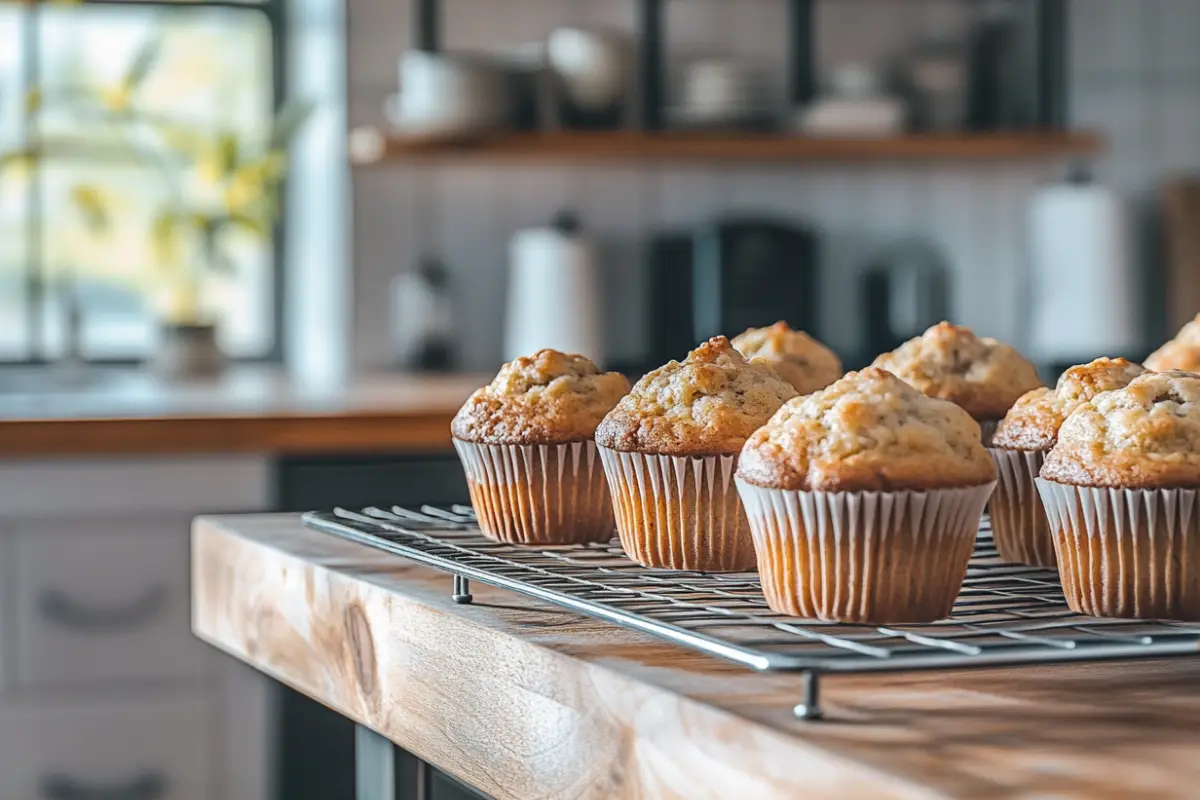Last Updated on March 7, 2025 by Simon
There’s nothing more disappointing than pulling a batch of muffins out of the oven, only to find that they’ve turned out soggy on the bottom. You’ve followed the recipe perfectly, your muffins look golden on top, but as soon as you peel back that wrapper, you’re faced with a damp, heavy base that ruins the texture you were hoping for. So, what’s going wrong?
Understanding how to keep muffins from being soggy on the bottom is a key skill for both beginner and experienced bakers. This issue usually stems from excess moisture or improper cooling techniques, but the good news is that it’s entirely preventable with a few adjustments to your baking process. Whether you’re making classic blueberry muffins, savory options, or even gluten-free varieties, soggy bottoms can be avoided once you know what to look out for.
In this guide, we’ll dive into the reasons behind this common muffin mishap and share practical, tried-and-true solutions to keep your muffins fluffy, light, and perfectly baked all the way through. With these tips, you’ll never have to worry about soggy muffin bottoms again!
Table of contents
Why Muffins Get Soggy on the Bottom and How to Fix It
To solve the problem of soggy muffin bottoms, it’s essential to understand what causes it. Several factors contribute to excess moisture in muffins, from the baking process to the cooling method. Below, we’ll break down the most common reasons for soggy-bottomed muffins and offer practical solutions that work every time.
1. Overmixing the Batter (Leads to Dense and Moist Muffins)
One of the most common mistakes is overmixing the muffin batter. When you overwork the flour, you activate too much gluten, resulting in dense muffins that trap moisture in the bottom. This leads to a heavy, soggy base that feels almost wet when you bite into it.
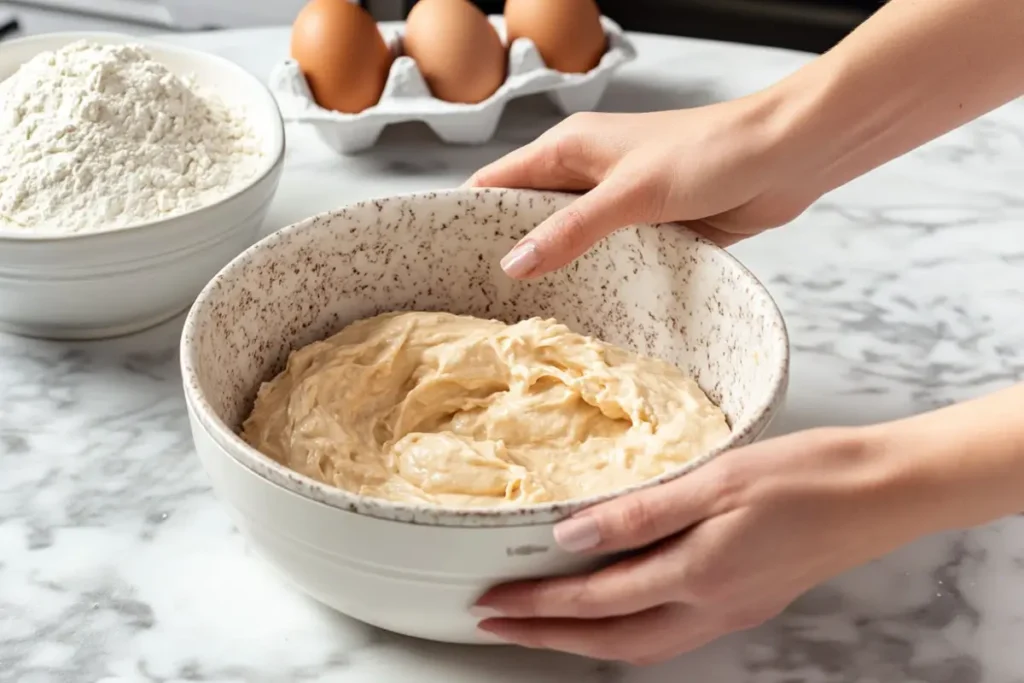
Solution:
Mix the batter gently and just until the ingredients are combined. It’s okay if the batter looks lumpy, that’s what you want! Overmixing can ruin the texture, so aim to fold the wet and dry ingredients together until you see no streaks of flour.
Pro Tip: Use a spatula to fold the ingredients instead of a whisk or mixer. This helps prevent overmixing and keeps the muffins light and fluffy.
2. Using Too Much Liquid in the Recipe
Another major culprit of soggy muffin bottoms is excess liquid in the recipe. If your muffins are too wet, they won’t bake evenly, and the bottom will remain moist even after the top looks done.
Solution:
Double-check the liquid-to-dry ingredient ratio in your recipe. If you’ve been adding extra milk, oil, or eggs, it could be throwing off the balance. Stick to the recipe’s measurements and avoid adding extra liquid unless you know how it will affect the texture.
Pro Tip: If you live in a humid climate, consider slightly reducing the liquid content, as moisture in the air can also affect your batter.
3. Muffins Cooling in the Pan (Traps Steam)
A huge factor in soggy bottoms is improper cooling. Muffins continue to release steam after baking, and if they cool in the muffin tin, that steam has nowhere to escape. Instead, it collects at the bottom of the muffins, leaving you with a wet, soggy layer.
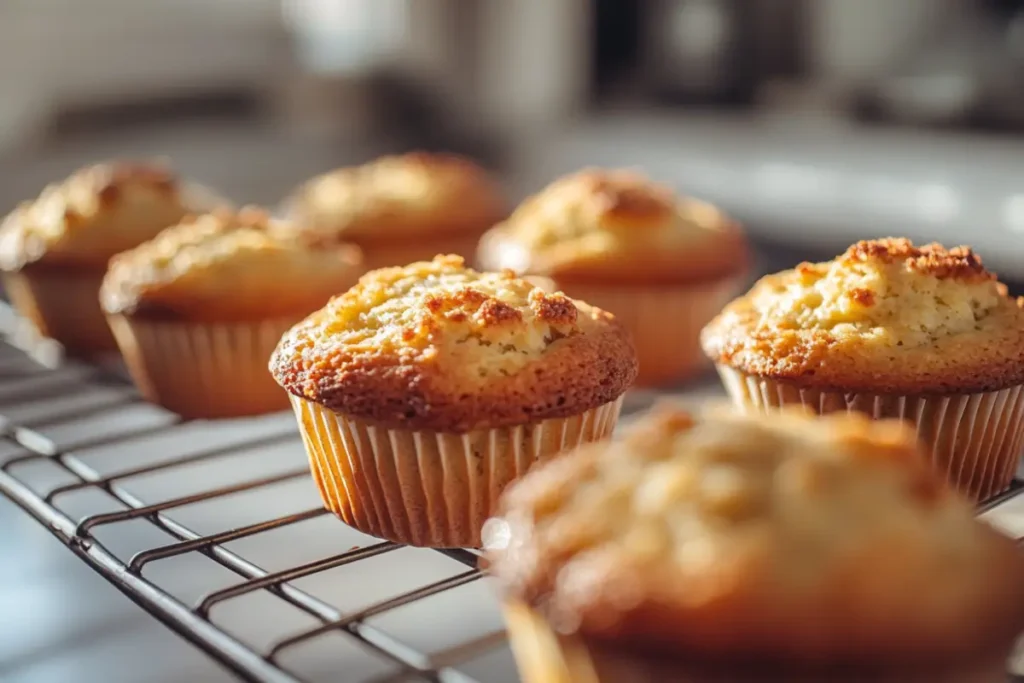
Solution:
As soon as your muffins come out of the oven, transfer them to a wire rack. This allows air to circulate around the muffins and prevents steam from getting trapped underneath.
Pro Tip: If you notice moisture collecting in the muffin pan, wipe it dry before placing the next batch in.
4. Using Paper Liners (Can Hold Moisture)
Paper liners are convenient, but they can sometimes contribute to soggy muffin bottoms. If the batter seeps through the liner or if the liner traps steam, the bottom of your muffin can end up wet.
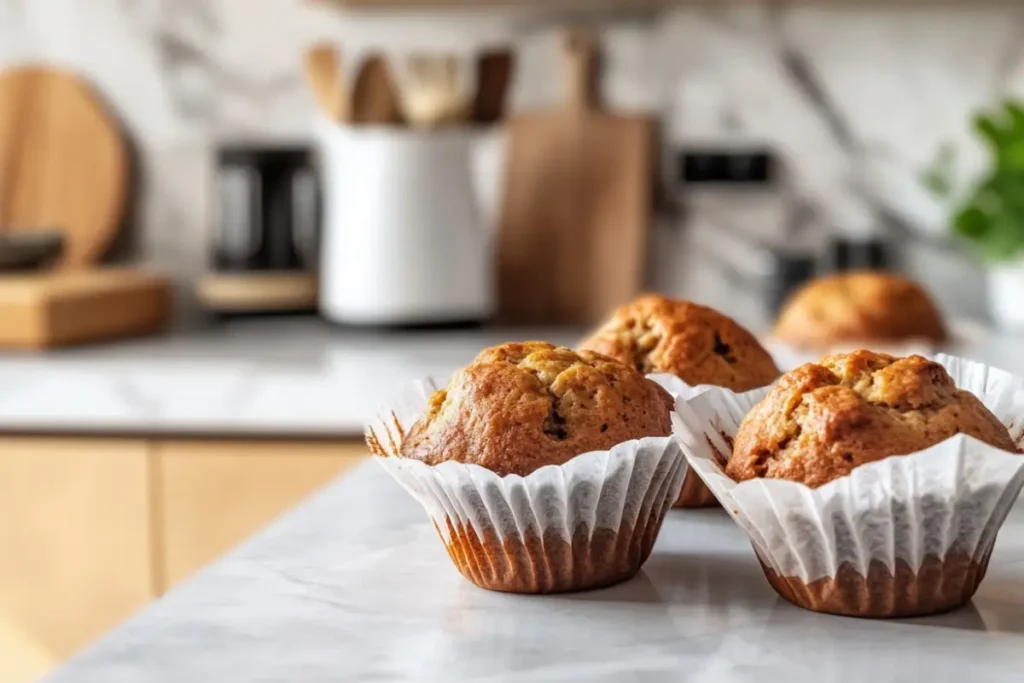
Solution:
Try using high-quality parchment paper liners, which are more moisture-resistant. Alternatively, bake your muffins directly in a well-greased muffin tin to reduce the chance of sogginess.
Pro Tip: If you must use liners, let the muffins cool for a few minutes, then carefully remove them from the liners to let the bottoms dry out.
5. Incorrect Oven Temperature (Affects the Bake)
Baking muffins at the wrong temperature can also cause soggy bottoms. If the oven is too cool, the muffins won’t bake properly, leading to undercooked, dense bottoms. Alternatively, if the temperature is too high, the top will bake too quickly, leaving the bottom wet.
Solution:
Preheat your oven to the correct temperature (usually around 375°F or 190°C for most muffins). Use an oven thermometer to ensure accuracy, as many ovens run hotter or cooler than their settings indicate.
Pro Tip: Avoid opening the oven door frequently while baking. This can cause temperature fluctuations, affecting how evenly the muffins bake.
6. Storing Muffins Improperly (Leads to Moisture Build-Up)
Even perfectly baked muffins can become soggy if stored incorrectly. When muffins are placed in an airtight container while still warm, the trapped steam creates condensation, which makes the muffins soggy over time.
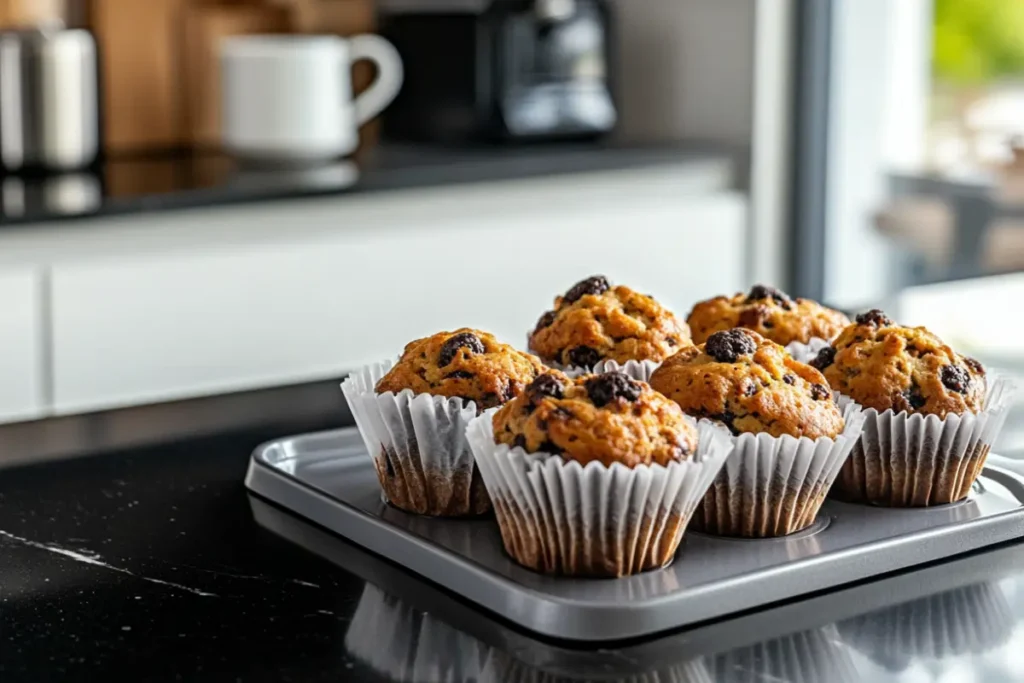
Solution:
Allow muffins to cool completely before storing them. Once cooled, store them in a container with a paper towel at the bottom to absorb excess moisture. Place another paper towel on top before sealing the container.
Pro Tip: For longer storage, freeze your muffins. When you’re ready to eat them, thaw them at room temperature or warm them in the oven for a freshly baked feel.
7. Adding Too Many Wet Ingredients (Like Fruit or Veggies)
Ingredients like fresh fruits, vegetables, or even yogurt can add too much moisture to your muffin batter. While they enhance flavor and texture, they also increase the risk of soggy bottoms if not handled correctly.
Solution:
Pat any fruits or vegetables dry before adding them to the batter. If using frozen fruits, toss them in a bit of flour before folding them into the mix to prevent them from releasing too much moisture during baking.
Pro Tip: Stick to the recommended measurements for add-ins, and don’t go overboard with ingredients like applesauce or mashed banana.
Pro Tips for Preventing Soggy Muffin Bottoms
Perfect muffins don’t happen by accident, they’re the result of following smart baking practices and paying attention to key details. If soggy-bottomed muffins have been a problem for you, these pro tips will ensure your muffins come out perfectly every time, with a golden, fluffy texture from top to bottom.
1. Don’t Leave Muffins in the Pan Too Long
Leaving muffins to cool in the pan is one of the most common mistakes. The pan retains heat after baking, which continues to cook the muffins and trap steam. This steam has nowhere to escape, causing the bottom to become soggy.
Pro Tip:
As soon as your muffins are cool enough to handle (usually after about 5 minutes), carefully transfer them to a wire rack. The airflow around the muffins will prevent condensation from forming underneath.
2. Use Parchment Liners Instead of Standard Paper Liners
Standard paper muffin liners can absorb moisture from the batter and hold it against the muffin’s bottom, causing sogginess. Switching to parchment paper liners can make a big difference.
Why It Works:
Parchment liners are moisture-resistant, meaning they won’t soak up excess liquid like regular paper liners. Alternatively, you can skip liners altogether and grease your muffin tin thoroughly for even better results.
3. Measure Ingredients Precisely
Accurate measurements are critical in baking. Too much liquid, whether from milk, oil, or wet add-ins like fruits, can result in muffins that don’t set properly on the bottom.
Pro Tip:
Use a kitchen scale to weigh your ingredients, especially flour. Too much flour will make muffins dry, but too little will make them dense and prone to soggy bottoms.
4. Avoid Overfilling the Muffin Cups
Overfilling the muffin cups can cause batter to spread unevenly, leading to inconsistent baking. Muffins that don’t bake evenly often have undercooked, wet bottoms.
Pro Tip:
Fill muffin cups about 2/3 full. This allows room for the muffins to rise properly without overflowing, ensuring even baking throughout.
5. Adjust for Humidity and Weather
Baking in a humid environment can introduce additional moisture into your batter. Even if you follow the recipe perfectly, high humidity levels can throw off the liquid balance.
Pro Tip:
In humid conditions, reduce the liquid in your recipe slightly (by about 1 to 2 tablespoons). You can also store flour in a dry, airtight container to prevent it from absorbing moisture from the air.
6. Let Frozen Ingredients Thaw Before Baking
Using frozen fruit or add-ins without thawing them first can increase the risk of soggy muffins. Frozen items release water during baking, which can settle at the bottom of your muffins.
Pro Tip:
Thaw frozen fruit before adding it to your batter, and pat it dry with a paper towel. If you’re in a rush, toss the frozen fruit in flour before mixing it into the batter to help absorb excess moisture.
7. Use the Right Baking Temperature
Baking muffins at the right temperature ensures they rise properly and bake evenly. Muffins baked at too low a temperature may look done on the surface but remain undercooked inside, leading to soggy bottoms.
Pro Tip:
Preheat your oven to the correct temperature, usually 375°F (190°C) for most muffin recipes. Use an oven thermometer to ensure accuracy, as many ovens have temperature variations.
8. Store Muffins Correctly to Prevent Condensation
Proper storage is key to keeping muffins fresh and preventing sogginess over time. If you place warm muffins in a container, the trapped heat will create condensation, which can make the muffins soggy.
Pro Tip:
Let muffins cool completely before storing them. Line the container with a paper towel on the bottom and top to absorb any excess moisture. For longer storage, freeze muffins instead of refrigerating them, as refrigeration can dry them out.
Common Variants of Muffins and How They Affect Sogginess
Not all muffins are created equal, different types of muffins require slightly different baking methods to avoid soggy bottoms. Factors like add-ins (fruit, vegetables, cheese), flour types, and sweeteners all impact moisture levels in the batter, meaning the strategies you use to prevent sogginess may need to be adjusted depending on the muffin variant. Let’s explore some of the most common muffin types and how to prevent soggy bottoms with each.
1. Fruit-Filled Muffins (Blueberry, Banana, Apple)
Fruit-filled muffins are classic and delicious, but fresh fruits can be a sneaky cause of soggy bottoms. Fruits naturally release juice during baking, which can pool at the bottom of your muffins if not handled correctly.
What Causes Sogginess?
- High water content in fresh fruits
- Frozen fruits that release moisture during baking
- Overripe fruits, like bananas, that are naturally wetter
How to Fix It:
- Pat Fresh Fruit Dry: If you’re using fresh fruits like blueberries or apples, pat them dry with a paper towel before folding them into the batter.
- Toss in Flour: Coat fruits in a small amount of flour before adding them to the batter. This helps absorb excess moisture and keeps the fruit suspended in the batter instead of sinking to the bottom.
- Limit Wet Fruits: Avoid using too many high-moisture fruits in one batch. Stick to the recipe’s measurements for fruits and don’t overdo it.
2. Savory Muffins (Cheese, Bacon, Vegetables)
Savory muffins are becoming increasingly popular for brunches and snacks. However, ingredients like cheese, bacon, and vegetables can introduce a lot of moisture, increasing the risk of a soggy base.
What Causes Sogginess?
- High-fat cheeses that release oil
- Vegetables with high water content (like zucchini or spinach)
- Bacon grease that isn’t properly drained
How to Fix It:
- Drain Grease from Bacon: If using bacon or sausage in your muffins, be sure to drain the grease thoroughly before adding it to the batter.
- Use Harder Cheeses: Softer cheeses like mozzarella can release more liquid during baking. Opt for harder cheeses like cheddar or Parmesan, which don’t release as much moisture.
- Squeeze Moisture Out of Veggies: If your recipe calls for vegetables like zucchini or spinach, grate or chop them finely and squeeze out excess water with a paper towel before mixing them into the batter.
3. Gluten-Free Muffins
The Gluten-free muffins often have a different texture and moisture balance compared to traditional muffins. Gluten-free flours like almond flour or coconut flour absorb liquid differently, and the lack of gluten can lead to structural issues that cause soggy bottoms.
What Causes Sogginess?
- Overly wet batters from high-moisture flours (like almond flour)
- Lack of gluten structure to hold the muffin together
- Too much liquid added to compensate for dryness
How to Fix It:
- Use a Blend of Gluten-Free Flours: Instead of relying on a single type of gluten-free flour, use a blend that balances moisture absorption and structure.
- Don’t Overdo the Liquids: Follow the recipe’s liquid measurements carefully. Adding more liquid to gluten-free batters in an attempt to make them moist can backfire by making them too wet.
- Let Muffins Cool Completely: Gluten-free muffins are more fragile when warm. Let them cool fully on a wire rack before removing them from the pan to avoid soggy bottoms.
4. Vegan Muffins
Vegan muffins, which lack eggs and dairy, often use ingredients like applesauce, mashed bananas, or plant-based yogurt as substitutes. These ingredients are naturally high in moisture and can easily lead to soggy muffin bottoms if not managed well.
What Causes Sogginess?
- Overuse of wet egg replacers (applesauce, mashed bananas)
- Plant-based yogurts with a high water content
- Oils that aren’t absorbed properly by the batter
How to Fix It:
- Choose the Right Egg Replacer: Instead of using only wet egg replacers, try chia or flaxseed eggs, which help bind the batter without adding extra moisture.
- Balance the Wet and Dry Ingredients: If you’re using a wet substitute like applesauce, reduce the liquid elsewhere in the recipe to compensate.
- Check Plant-Based Yogurt Consistency: Use thicker plant-based yogurts (like Greek-style alternatives) instead of watery ones to avoid adding too much moisture.
5. Whole Wheat or Bran Muffins
Whole wheat and bran muffins are denser and more absorbent than muffins made with all-purpose flour. However, they can become soggy if there’s too much moisture in the batter or if they’re underbaked.
What Causes Sogginess?
- Dense batters that trap moisture
- Overuse of add-ins like honey or molasses
- Underbaking due to the dark color of the batter (which makes it harder to judge doneness)
How to Fix It:
- Bake Longer at a Lower Temperature: Whole wheat muffins may need a slightly longer baking time to ensure the center is fully cooked. Try baking at 350°F (175°C) instead of the usual 375°F to avoid overbrowning the tops.
- Limit Liquid Sweeteners: Use granulated sweeteners (like brown sugar) instead of honey or molasses if possible. Liquid sweeteners can make the batter too wet.
- Test for Doneness Carefully: Use a toothpick to check the center of the muffins for doneness. Make sure it comes out clean before removing the muffins from the oven.
No More Soggy Muffin Bottoms!
There’s nothing more satisfying than baking a batch of muffins that come out fluffy, golden, and perfectly baked from top to bottom. Understanding how to keep muffins from being soggy on the bottom requires a bit of troubleshooting, but once you know the key factors, from proper mixing techniques to cooling and storage, you’ll be on your way to consistently perfect muffins.
Whether you’re making classic blueberry muffins, savory breakfast options, or experimenting with gluten-free or vegan variations, these practical tips will help you achieve bakery-quality results at home. Pay close attention to how you prepare, bake, and cool your muffins to avoid excess moisture buildup.
Remember, small adjustments make a big difference! A few simple tweaks, like using parchment liners, checking your oven temperature, and storing muffins properly, can turn soggy-bottom disasters into light, fluffy treats every time. With this guide, you’ll never have to peel off a muffin wrapper to reveal a disappointing soggy base again.
If you’re ready to put your muffin-making skills to the test, try our Easy Gaps Raisin Muffins Recipe: Perfect for Your Diet Plan. These muffins are light, flavorful, and designed to fit perfectly into a healthy eating routine. Don’t miss out on this delicious and nutritious option!

